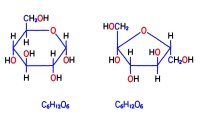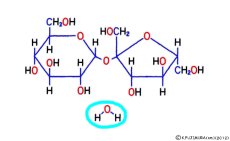[007] Glucose and the hydrolysis of sucrose (GB#101D01) | 基礎医学教育研究会(KIKKEN)Lab

● Grape sugar in human body
Glucose (grape sugar) is one of the most common substances in life context, not only in physiology. Among human bodies, glucose is actually large in quantity as sugar and appears in various physiological phenomena. The identity of human “blood sugar” is glucose. Why is “grape sugar” flowing in the human body?
–
Contents
● Grape sugar also in rice
Grape sugar is paraphrased as glucose in English in scientific world. However, the Japanese technical term “budou-tou” would have translated this English literally. When saying “sugar of grape”, there is an image like sugar peculiar to grapes. In fact, however, glucose is commonly found in fruits and vegetables other than grapes. Perhaps the food with the highest content of glucose may be rice (about 70%). However, the glucose of rice is present in the grain as a branched long chain substance, starch.
There are many disjointed glucose in the grape indeed. However, what came to be called sugar of grapes seems to be due to the fact that chemists happened to purify this sugar for the first time using grape (dried grape) as a material.
Glucose is also included in flower honey. However, instead of glucose alone, it is combined with fructose, the name of the fruit sugar, of glucose relatives and is in the form of sucrose. The dried sucrose purified is the familiar “sugar”.
Both glucose and fructose are molecules consisting of C6H12O6, six carbons, twelve hydrogens and six oxygens. It is a substance physiologically becoming the smallest unit as a sugar, and these are a group called monosaccharide.
A sugar such as sucrose in which two monosaccharides are bonded becomes a disaccharide.
Glucose (left) and fructose (right)

Sucrose and water molecules

Incidentally, the grape juice contains the same degree of glucose and fructose, and fructose is more than twice as sweet at the same concentration. Then fructose may be found as “glucose”? You might think. I do not know why it is not so.
● Glucose becomes an energy source
As written at the beginning, glucose is commonly present in animals’ bodies, including humans, and is doing important work. Rather, the substance essential for animals to live is glucose. Both glucose and fructose are sources of energy that cells live on. Every cell takes glucose and fructose intact and uses it as an energy source. But animals can not make glucose by themselves from the beginning. Although it deforms from other materials to make it glucose, even for that material, animals can not be made with their own body.
Grape sugar and fructose are made by plants, as the name suggests. Glucose is a package of energy that plants have confined the energy of sunlight in photosynthesis.
Animals eat this energy package and use it. Sugar “sweet” can be said to be a psychological mechanism by which animals instinctively want to eat it. Sweet happens to be not a coincidence result, but to be felt as sweet as a signal of an energy source in animals. The rice that the Japanese is eating most often as an energy source is not that sweet, but tired of being too sweet, it does not take the amount needed for the body everyday. It is working well. Sweetness seems to be a mechanism that attracts small animals originally. Whether an animal feels the same “sweetness” as humans is another story, it’s a little difficult, but it seems to taste like it anyway.
Speaking of anything sweet, it is honey that comes to mind. Food honey was originally stored by bee brought flower nectar to the nest. But honey and honey of flowers are not the same thing. It is a honey of bees. Once they carry it inhale the honey into the body. Then, with the function of the enzyme that the bee has, the majority of the honey sucrose is separated into glucose and fructose. Honey is a mixture of broken glucose and fructose.
Glucose is weaker than sucrose in sweetness, but honey is too sweet as fructose is much sweeter than sucrose.
On the other hand, for honey bees this may be just a sweetness.
Both honey bees and humans must incorporate glucose into cells when using glucose as an energy source. However, cells may be in the form of monosaccharides such as glucose and fructose, but they can not be absorbed with sucrose. This is the same when sugar is absorbed by the wall of the intestine, it can not be absorbed due to its large size with sucrose. So separate them before absorbing. In short this is the digestion of sugar occurring in the intestine. Bee does not go after eating, it digests and stores in the nest before eating.
Blood sugar is digested and the absorbed glucose is flowing through the blood before it is used for the cells of the body.
● Decomposition of sucrose
Well, it is finally this theme.
Separating sucrose into glucose and fructose is chemically called decomposition.
It does not just detach the connected parts. A proper procedure is required.When separating sugar, each side is exposed, so it is a procedure to clean it. To do this, it is easiest to attach hydrogen and hydroxyl groups created by decomposing one of the molecules of water into each stump breakdown of sucrose. That’s because there are so many molecules of water around. This method is called hydrolysis because it decomposes by adding water molecules.
Hydrolysis of sucrose is a reaction in which energy of 5.5 kcal/mol is liberated. This seems to be a reaction which arbitrarily progresses even if left alone when comparing only before and after. However, this reaction will not proceed arbitrarily as activation energy to become a barrier is required before decomposition. Therefore, in the body hydrolysis is done by a specific enzyme. The enzyme that hydrolyzes sucrose is sucrase in the human body. In bees, another enzyme works the same.

Since hydrolysis requires the action of an enzyme, even when saying “decomposition with addition of water”, even if sugar and water are mixed it will not be decomposed into glucose and fructose alone.
On the contrary, the reaction to synthesize sucrose from glucose and fructose is opposite to hydrolysis, and it combines stumps by taking away hydrogen and hydroxyl groups from each sugar. As a result, since one water molecule is completed, it is called dehydration synthesis. This also requires specific enzymes. Furthermore, in order to combine glucose and fructose further, energy of 5.5 kcal/mol has to be introduced as opposed to decomposition. That energy must come from somewhere.
Synthesis of sucrose is done by plants photosynthesized by receiving energy from the sun. Sucrose is not synthesized in the animal’s body.
The reaction of hydrolysis and dehydration synthesis is a commonly used method for decomposing and synthesizing various substances in the body. Humans do not make sucrose, but dehydrate and synthesize other important substances. It will be introduced another.
[Correction] [007] (glucose and hydrolysis of sucrose), the expression form of glucoside bond of sucrose was incorrect, so we fixed it. If someone already uses it, I am sorry, but please replace it. (Structural charts are difficult because the conventions are strictly rigorous.) 2013-5-26
* To further supplement biochemical things, fructose is most often called β-D-fructofuranose type. When drawing a single structural diagram in the same arrangement as glucose, the –OH group that binds to glucose is on the right of the figure and comes on top of C. The above animation is drawn so that the bonds are arranged side by side in accordance with the physiology textbook, and looks like a different structure, but fructose is β-D-fructofuranose.
⇒ If you would like to know more about “glucose” and “fructose”
・Carbohydrate / Arita Laboratory (Tokyo Univ.) wiki
・Carbohydrate / functional biochemistry laboratory (Fukuoka University)
・Glucose /wikipedia
・Fructose /wikipedia
⇒If you want to know more about “honey”
⇒Who would like to know more about “hydrolysis”
⇒Honey bee’s whisper diary (~ Nagasaki letter) (Link broken) Honey bees have recently declined dramatically worldwide.
○ Related articles
◆[017] 糖質の吸収 absorption of carbohydratel ![]()
◆[047] Glycolysis ![]()
◆[019] アデノシン三リン酸(ATP) adenosine triphosphate ![]()
◆[042] TCA cycle ![]()
◆[012] 分節運動 intestinal segmentation ![]()
◆[027] ペプチド結合 peptide bond ![]()
◆[030] エンドサイトーシスと細胞内消化 endocytosis and intracellular digestion ![]()
◆[032] グリコーゲンの合成 glycogen synthesis ![]()
◆[046] Digestion and metabolism ![]()
◆[050] Cellular respiration ![]()
○ Referenced books
・プロッパー細胞生物学,化学同人
・Essential細胞生物学〈DVD付〉原書第3版,南江堂
・カラー図解 人体の正常構造と機能 全10巻縮刷版,坂井 建雄,日本医事新報社
・人体機能生理学,杉 晴夫,南江堂
・トートラ人体解剖生理学 原書8版,丸善
・イラスト解剖学,松村 讓兒,中外医学社
・柔道整復学校協会編「生理学」,南江堂
・東洋療法学校協会編「生理学」,医歯薬出版株式会社
お勉強に疲れたら... ⇒ カラパイアはどうでしょう?
rev.20151231, rev.20150117, rev.20160508,rev.20170208,rev.20170502, rev.20180125.
KISO-IGAKU-KYOIKU-KENKYUKAI(KIKKEN)







